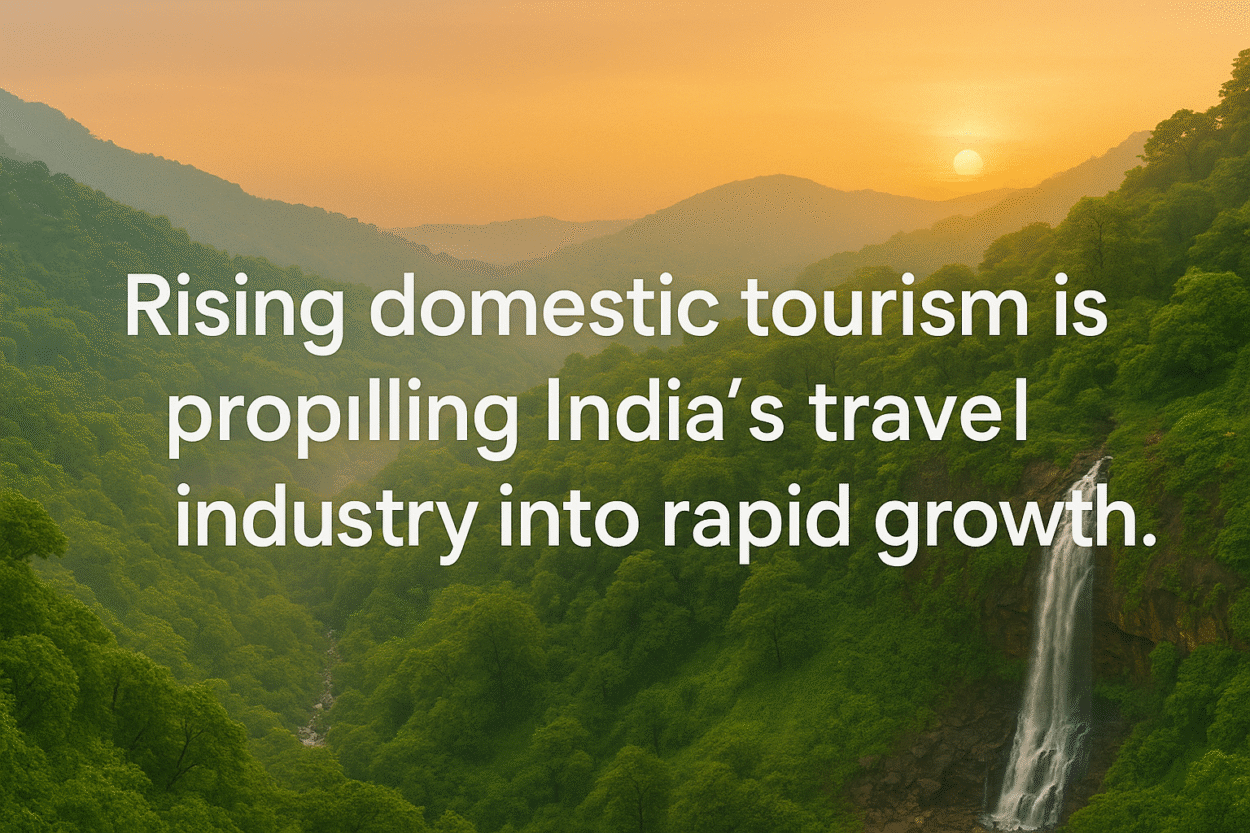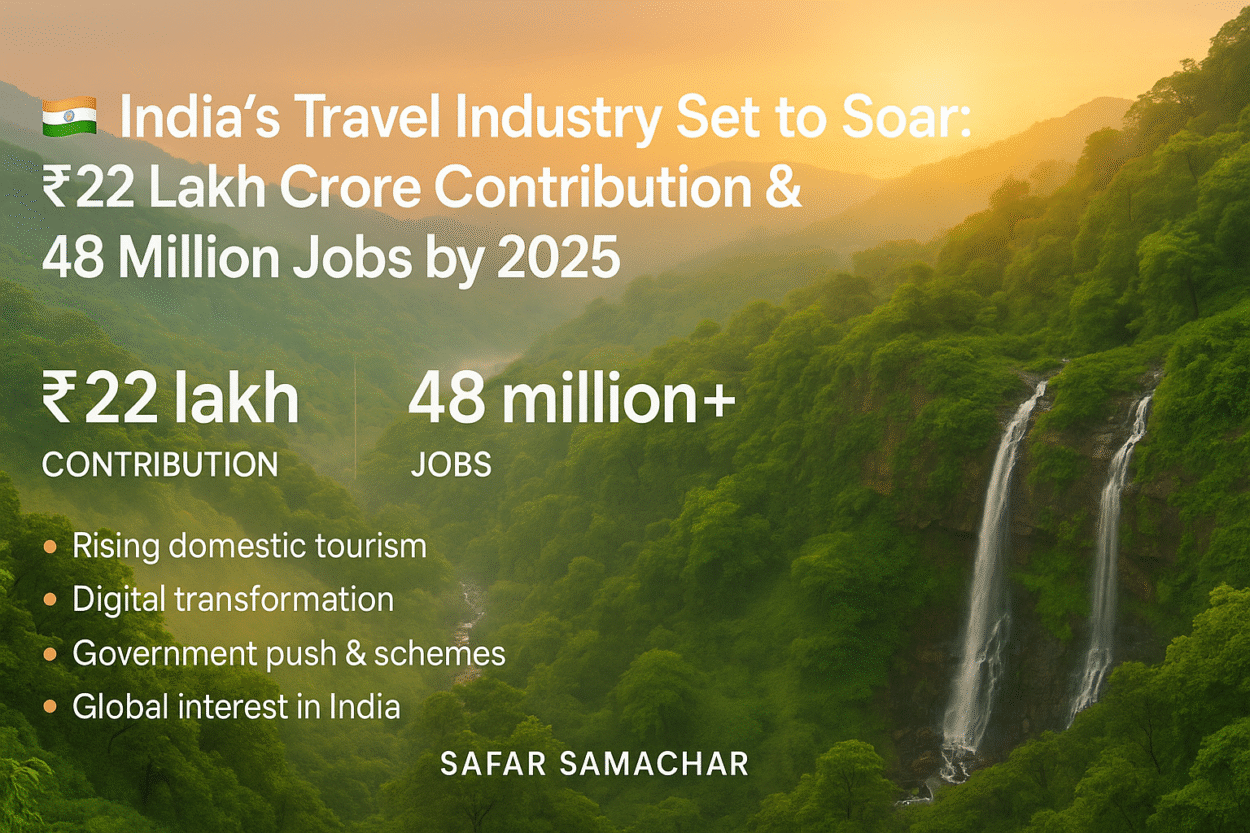Introduction:
India’s travel industry is not just bouncing back—it’s booming. As the world reopens and travel redefines itself post-pandemic, India is emerging as one of the most promising tourism hubs globally. With a rich tapestry of culture, heritage, landscapes, and spiritual destinations, the country is poised to become a global tourism powerhouse by 2025.
According to the latest World Travel and Tourism Council (WTTC) report, the Indian travel and tourism sector is projected to contribute a staggering ₹22 lakh crore to the national economy in 2025. What’s more? The sector is expected to support over 48 million jobs, making it one of the largest employment-generating industries in the country.
At Safar Samachar, we’re breaking down what this growth means, what’s driving it, and how you—whether a traveler, entrepreneur, or dreamer—can be a part of this exciting journey.

📈 India’s Travel Boom: What the Numbers Say
Here’s a quick snapshot of the growth forecast for India’s tourism sector:
- ₹22 lakh crore contribution to the GDP by 2025
- 48 million+ jobs expected to be supported by the sector
- Domestic and international tourism both driving growth
- Government investment and private partnerships fueling expansion
These numbers show more than economic gain—they represent millions of stories, experiences, and opportunities waiting to unfold.
While many people shy away from travel during this time, seasoned explorers know that some of the best places to visit in rainy season in India reveal their true beauty when drenched in rain. The air is fresher, hotel rates are often lower, and nature is at its vibrant best.
At Safar Samachar, we believe the monsoon is the perfect time to rediscover India’s natural beauty. So whether you’re chasing clouds, sipping hot chai with a view, or walking through misty hills, monsoon travel offers a soulful escape that’s hard to beat.
🌍 Why Is India’s Tourism Industry Growing So Fast?
- Rising Domestic Tourism
More Indians than ever are exploring their own country. From remote mountain retreats to beach escapes and cultural festivals, the diversity within India is turning locals into passionate explorers. - Digital Transformation
Online travel bookings, mobile-first platforms, influencer-driven content, and AI-based travel planning have made traveling more accessible and personalized. - Government Push & Schemes
Initiatives like Dekho Apna Desh, PRASAD, and Swadesh Darshan 2.0 are creating world-class tourism circuits, infrastructure, and heritage promotion. - Global Interest in India
International travelers are seeking more immersive and authentic experiences. India’s yoga, wellness, cuisine, and spiritual destinations attract millions from abroad.
Affordable Travel Options
With budget airlines, eco-stays, homestays, and better connectivity, travel is now possible for many who once thought it was out of reach.
🌐 Key Growth Areas in the Travel Sector
- 🏕️ Eco & Adventure Tourism
Destinations like Rishikesh, Spiti, and Meghalaya are booming thanks to interest in offbeat and sustainable experiences. - 🕌 Spiritual & Heritage Tourism
From Varanasi to Hampi, more tourists are engaging with India’s spiritual and historical richness. - 🧘 Wellness & Medical Tourism
Ayurveda retreats, yoga centers, and world-class hospitals are attracting global visitors for health and healing. - 🎡 MICE & Luxury Travel
India is becoming a hub for international conferences, destination weddings, and luxury getaways.
🧳 What This Means for Travelers & Stakeholders
For travelers, this growth means:
- More destinations with better infrastructure
- Competitive pricing and deals
- Diverse, high-quality experiences
For businesses, it means:
- Massive opportunity in hospitality, transport, events, and tech
- Rise in demand for skilled professionals
- Growing focus on sustainability and quality service
For job seekers:
- Tourism is expected to support 1 in every 9 jobs in India by 2025
Career growth in tour operations, digital marketing, hotel management, and more

📢 Travel Insights by Safar Samachar
As travel evolves in India, Safar Samachar brings you first-hand insights, updates, and tips to help you navigate and enjoy this new era of tourism. Here’s what we foresee:
- Tier-2 and Tier-3 cities becoming tourism hotspots
- Short weekend getaways and regional circuits gaining popularity
- Growth of eco-conscious and solo travelers
- Increase in regional content and language support for travelers
- Demand for experiential travel: from cooking with locals to forest stays
🌟 Conclusion: The Road Ahead is Bright
India’s travel industry is not just growing—it’s transforming. With ₹22 lakh crore in economic potential and 48 million lives set to be touched by tourism, the journey ahead is exciting, inclusive, and inspiring.
Whether you’re a backpacker, blogger, hotelier, or just someone who loves exploring new places—the Indian travel wave is calling. Be part of it.
At Safar Samachar, we’re committed to guiding you through this journey with curated guides, local stories, and the latest travel updates. Because travel is not just about going places—it’s about understanding them, living them, and letting them change you.
Whether you’re chasing waterfalls, sipping chai in the mountains, or exploring ancient forts drenched in rain, every monsoon destination has a unique story to tell. These are not just places to visit in monsoon in India—they’re experiences that stay with you long after the clouds clear.
At Safar Samachar, we believe travel should be meaningful, magical, and mindful. So pack your bags, embrace the rain, and explore the hidden gems this monsoon. And don’t forget to follow us for more travel guides, tips, and handpicked itineraries across India.
✅ Explore more stories from India’s growing travel scene
Stay tuned to Safar Samachar – India’s trusted voice for travel trends, destinations, and inspiration.
❓ FAQs About India’s Travel Industry Growth
What is the economic contribution of tourism to India in 2025?
Tourism is projected to contribute over ₹22 lakh crore to India’s GDP in 2025, making it one of the biggest sectors in the economy. This includes income from domestic, inbound, and outbound travel, hospitality, and related services.
How many jobs will tourism support in India by 2025?
The sector is expected to support 48 million+ jobs, covering everything from hotel staff and guides to digital marketers, drivers, and event professionals. That’s nearly 1 in every 9 jobs in India!
Which travel trends are shaping India’s tourism boom?
Major trends include eco-tourism, offbeat destinations, cultural circuits, solo travel, regional experiences, and smart bookings via mobile and AI platforms. Today’s traveler wants meaningful, immersive journeys, not just sightseeing.
Is the government investing in tourism?
Yes, significantly. Initiatives like Swadesh Darshan 2.0 (theme-based circuits), PRASAD (pilgrimage sites), and Dekho Apna Desh (domestic awareness) are boosting tourism infrastructure, skill development, and regional connectivity.
What are the top sectors in tourism for jobs?
Key sectors include hospitality (hotels/resorts), transportation, adventure tourism, eco-tourism, medical/wellness tourism, and travel tech. There’s a growing demand for skilled professionals in digital content, travel planning, and sustainable travel.
Is international tourism returning to India?
Yes. After pandemic lows, international arrivals are rising due to simplified visa policies, global marketing efforts, and India’s increasing visibility as a safe, affordable, and culturally rich destination.
How is digital media influencing tourism?
From influencer videos and Instagram reels to AI-based travel planners and real-time reviews, digital media plays a key role in inspiring and informing travelers. It also helps lesser-known places gain popularity.
Are new destinations being developed?
Absolutely. States like Odisha, Chhattisgarh, Jharkhand, and Northeast India are investing in sustainable tourism and infrastructure. These regions offer unique experiences in nature, culture, and adventure—perfect for the modern traveler.
h, and the Northeast are opening up for tourism with fresh experiences.
Is tourism helping rural areas?
Yes. Rural and community-based tourism is providing income to locals, preserving traditional crafts, and offering authentic experiences to travelers. Many villages are becoming self-reliant hubs thanks to tourism.
How can I be part of India’s travel revolution?
You can explore lesser-known destinations, support local artisans and homestays, or even start a travel venture, blog, or YouTube channel. Tourism in India is becoming more inclusive, sustainable, and tech-driven—perfect for innovators and explorers.
